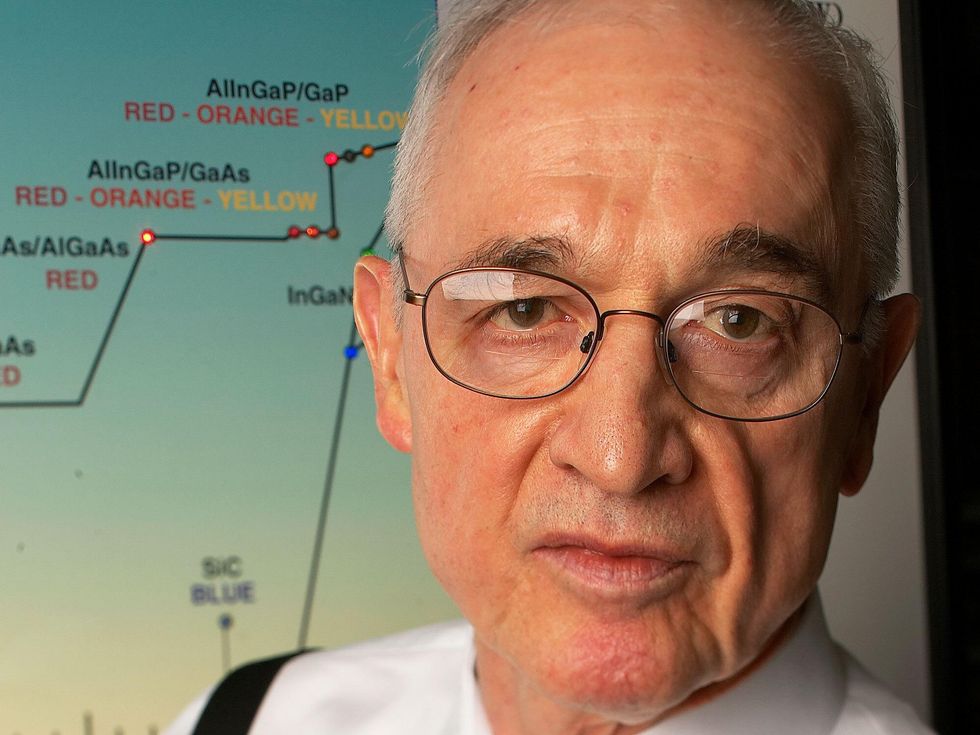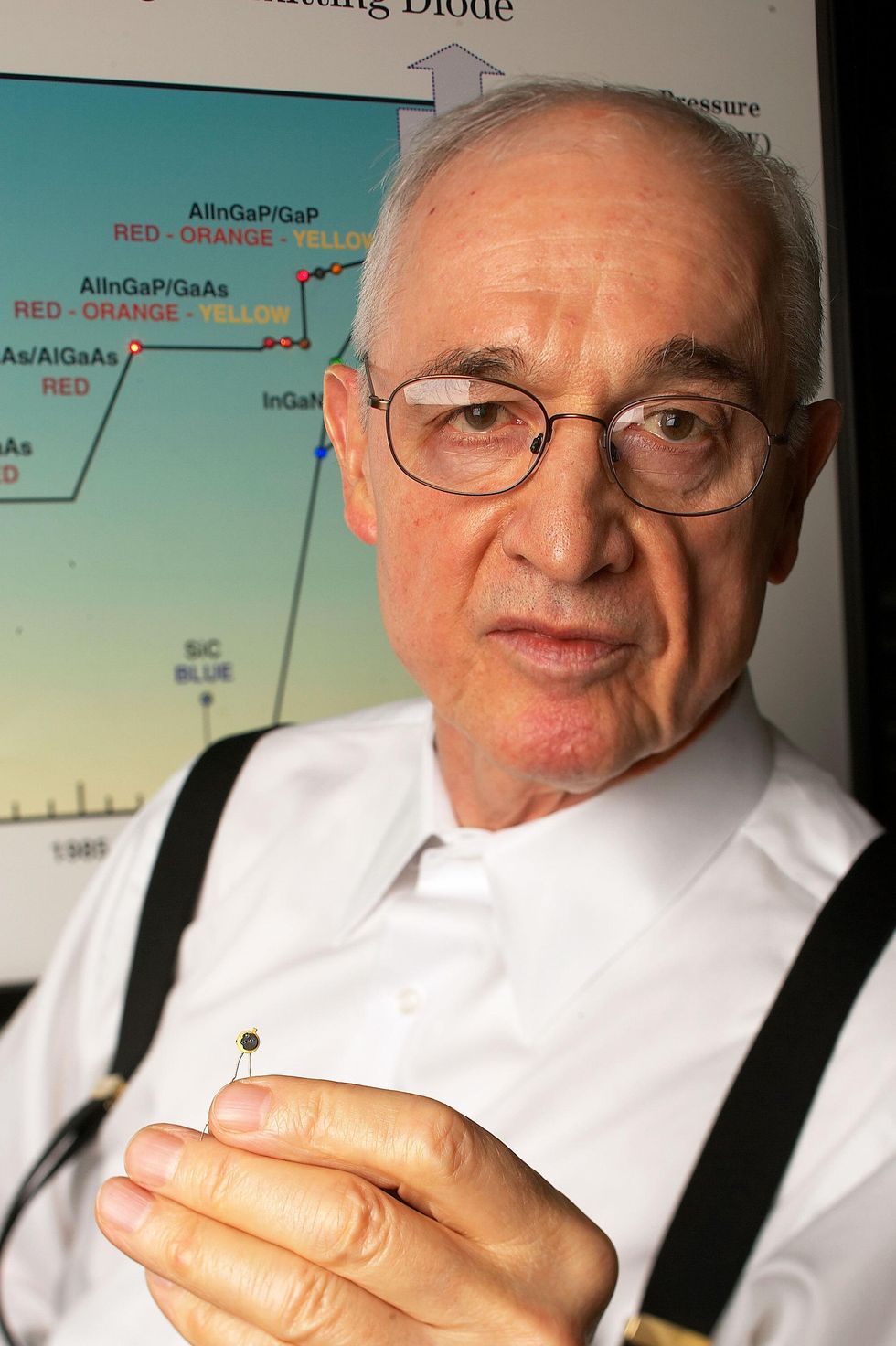
Remembering LED Pioneer Nick Holonyak


Nick Holonyak, Jr. retains a component of a stoplight that makes use of a newer LED developed by his students. Ralf-Finn Hestoft/Getty Photos
Nick Holonyak Jr., a prolific inventor and longtime professor of electrical engineering and computing, died on 17 September at the age of 93. In 1962, although doing work as a consulting scientist at Basic Electrical’s Innovative Semiconductor Laboratory, he invented the very first sensible noticeable-spectrum LED. It is now employed in light-weight bulbs and lasers.
Holonyak still left GE in 1963 to become a professor of electrical and laptop engineering and researcher at his alma mater, the College of Illinois Urbana-Champaign. He retired from the college in 2013.
He been given the 2003 IEEE Medal of Honor for “a vocation of pioneering contributions to semiconductors, together with the growth of semiconductor alloys and heterojunctions, and to visible mild-emitting diodes and injection lasers.”
LED and other semiconductor sector breakthroughs
Following Holonyak acquired bachelor’s, master’s, and doctoral levels in electrical engineering from the University of Illinois, he was hired in 1954 as a researcher at Bell Labs, in Murray Hill, N.J. There he investigated silicon-dependent electronic devices.
He left in 1955 to serve in the U.S. Military Signal Corps, and was stationed at Fort Monmouth, N.J., and Yokohama, Japan. Following staying discharged in 1957, he joined GE’s Sophisticated Semiconductor Laboratory, in Syracuse, N.Y.
When at the lab, he invented a shorted emitter thyristor system. The 4-layered semiconductor is now observed in gentle dimmers and electric power resources. In 1962 he invented the red-light-weight semiconductor laser, regarded as a laser diode, which now is found in cellphones as perfectly as CD and DVD gamers.
Later that year, he demonstrated the very first seen LED—a semiconductor source that emits mild when current flows via it. LEDs beforehand had been built of gallium arsenide. He created crystals of gallium arsenide phosphide to make LEDs that would emit obvious, crimson mild. His function led to the enhancement of the substantial-brightness, high-performance white LEDs that are identified in a huge array of purposes today, together with smartphones, televisions, headlights, website traffic indicators, and aviation.
Groundbreaking research at the University of Illinois
Holonyak left GE in 1963 and joined the University of Illinois as a professor of electrical and laptop engineering.
In 1977 he and his doctoral college students shown the very first quantum well laser, which later located applications in fiber optics, CD and DVD players, and clinical diagnostic applications.
The university named him an endowed-chair professor of electrical and laptop or computer engineering and physics in 1993. The placement was named for John Bardeen, an honorary IEEE member who had obtained two Nobel Prizes in Physics as well as the 1971 IEEE Medal of Honor. Bardeen was Holonyak’s professor in graduate university. The two adult men collaborated on study projects until eventually Bardeen’s death in 1991.
Alongside one another with IEEE Lifetime Fellow Milton Feng, Holonyak led the university’s transistor laser research center, which was funded by the U.S. Defense Innovative Investigate Jobs Company. There they developed transistor lasers that had the two gentle and electric powered outputs. The innovation enabled high-pace communications technologies.
Additional lately, Holonyak produced a method to bend mild in just gallium arsenide chips, permitting them to transmit data by light alternatively than energy.
He supervised more than 60 graduate learners, quite a few of whom went on to develop into leaders in the electronics subject.
Queen Elizabeth prize, Draper prize, and other awards
Holonyak obtained very last year’s Queen Elizabeth Prize for Engineering the Nationwide Academy of Engineering’s 2015 Draper Prize the 2005 Japan Prize and the 1989 IEEE Edison Medal. In 2008 he was inducted to the Nationwide Inventors Hall of Fame, in Akron, Ohio.
He was a fellow of the American Academy of Arts and Sciences, the American Physical Modern society, and Optica. He was also a international member of the Russian Academy of Sciences. In addition Holonyak was a member of the U.S. Academies of Engineering and Sciences.
Read the comprehensive story about Holonyak’s LED breakthrough in IEEE Spectrum.
